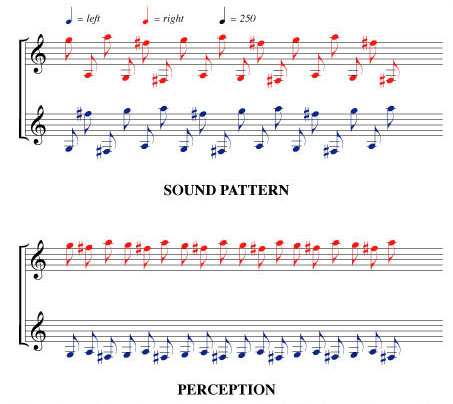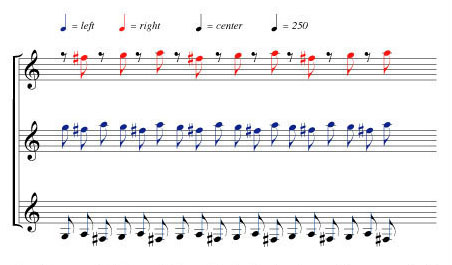| |
Cambiata Illusion
The Cambiata Illusion was discovered and first published by Deutsch on the CD 'Phantom Words and Other Curiosities' (2003)1. It can be heard either through stereo headphones, or through stereo loudspeakers, which are placed one to your right and the other to your left. The effect is strongest when listening through headphones. Before you begin, make sure that the loudspeakers on your sound system are turned off, and that the left and right channels are balanced for loudness. Then readjust the settings on your amplifier so that the sounds, as heard through the headphones, are somewhat on the soft side.
Now listen to the pattern. If you hear higher tones in one ear and lower tones in the other ear, decide which ear is hearing the higher tones. Then reverse the earphone positions and listen to the pattern again. Decide again which ear is hearing the higher tones.
 Listen to the Cambiata Illusion Listen to the Cambiata Illusion
Many people experience the illusion of a repeating higher melody in one ear, together with a repeating lower melody in the other ear. (Both these melodies are called 'cambiata figures'.). When the earphone positions are reversed, people often hear the same thing: The ear that had been hearing the higher melody continues to hear the higher melody, and the ear that had been hearing the lower melody continues to hear the lower melody. This produces the strange impression that the higher tones have migrated from one earphone to the other, and that the lower tones have migrated in the opposite direction. As another strange thing, right-handers are likely to hear the higher tones on the right and the lower tones on the left, regardless of how the earphones are positioned. But left-handers as a group vary considerably in terms of where the higher and the lower tones appear to be coming from.

| Figure 1. The pattern that produces Deutsch’s Cambiata Illusion, and a way it is often perceived. |
Other listeners experience different illusions. For example, some people hear one melody in the left ear that consists of all the higher tones, together with another melody in the right ear that consists of higher tones separated by pauses, and yet a third melody, that consists of all the lower tones, and appears to be located in the center of the head. Listeners who obtain complex percepts such as this one often experience different illusions at different times, so that the pattern appears to be constantly changing. Also, the different melodies sometimes appear to be disconnected in time, or the temporal relationships between them may appear to be quite complex. Interestingly, left-handers are more likely than right-handers to obtain complex percepts.

| Figure 2. Another way that Deutsch’s Cambiata Illusion is sometimes perceived |
Next try listening to the Cambiata Illusion through stereo loudspeakers, with one to your left and the other to your right. Listen first with the channels in balance. Then shift the balance all the way to the left. Then shift it all the way to the right. Then bring the channels back into balance again. Notice that when the channels are in balance, you hear a higher melody that consists of three tones that are close in pitch, together with a lower melody, that also consists of three tones that are close in pitch. Yet when each channel is played separately, you instead hear patterns that leap around in pitch. When the balance is equalized, your brain reorganizes the tones again, so that the two, smooth melodies return. In this way, your brain rejects the jerky, improbable patterns that are being produced by the loudspeakers or earphones, and reorganizes the sounds so as to create orderly patterns instead. This illusion is based on the same principle as I employed to create the Scale Illusion.
References:
1. Deutsch, D. Phantom Words, and Other Curiosities, 2003, La Jolla: Philomel Records.
2. Deutsch, D. (Ed.). Grouping mechanisms in music. Chapter 6 in The Psychology of Music, 3rd Edition, San Diego: Elsevier, 2013
3. Deutsch, D. Some musical illusions are discovered. Chapter 2 in Musical Illusions and Phantom Words: How Music and Speech Unlock Mysteries of the Brain, Oxford University Press. 2019.
4. Deutsch, D. Some musical illusions are discovered. Chapter 2 in Musical Illusions and Phantom Words: How Music and Speech Unlock Mysteries of the Brain, Korean translation, Eidos Publishing Group , 2023.
5. Deutsch, D. Some musical illusions are discovered . Chapter 2 in Musical Illusions and Phantom Words: How Music and Speech Unlock Mysteries of the Brain, Chinese translation, Guangxi Normal University Press, Group Co, Ltd., 2024.

| |